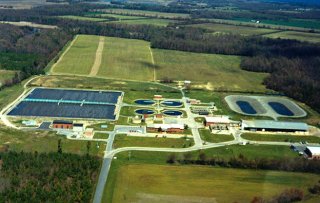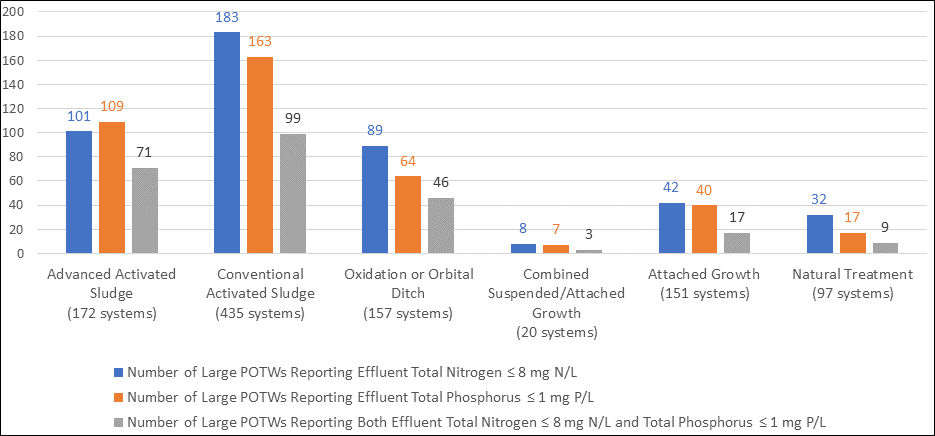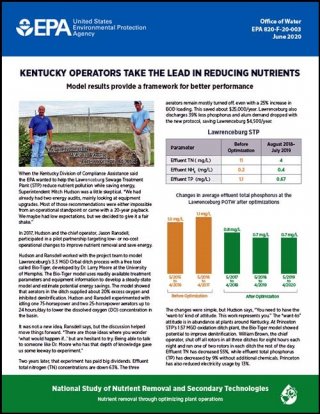National Study of Nutrient Removal and Secondary Technologies

The EPA is examining efficient and cost-effective approaches for nutrient removal at publicly owned treatment works (POTW). As part of the national study, the agency conducted a survey of POTWs during 2019 to 2021.
On this page:
- Study Goals
- Benefits to POTWs
- Nutrient Removal Accomplished Nationwide
- Fact Sheets
- Additional Resources
Study Goals

Some POTWs have added new treatment processes to remove nutrients, but these upgrades may not be affordable or necessary for all facilities. This study is helping EPA learn about other ways that POTWs are reducing their nutrient discharges, while optimizing operation and maintenance practices, and without incurring large capital expenses. The study has three main goals:
- Obtain nationwide data on nutrient removal.
- Encourage improved POTW performance with less expense.
- Provide a forum for stakeholders to share best practices.
Benefits to POTWs
-
Help POTWs optimize nutrient removal by providing operation and performance information from similar types of POTWs that have already achieved successful, cost-effective approaches to nutrient removal.
-
Serve as a major new nationwide data resource on nutrient removal to help stakeholders evaluate and develop achievable nutrient reduction values.
-
Provide a rich database of nutrient removal performance for POTWs, states, academic researchers, and other interested parties.
POTWs have already seen the benefits of low-cost optimization. In 2012, the Montana Department of Environmental Quality began training POTW staff in the state on nutrient removal and optimization. POTWs whose staff fully engaged in the optimization process significantly reduced their nutrient discharges. Refer to the Fact Sheets.
Nutrient Removal Accomplished Nationwide
Initial results of the screener questionnaire help demonstrate an important aspect of the National Study: improved nutrient removal is attainable by all types of POTWs. Survey results to date show more than 1,000 POTWs with different biological treatment types (including both conventional and advanced treatment technologies) can achieve effluent total nitrogen of 8 mg/L and total phosphorus of 1 mg/L. The figure below includes those POTWs with a population served of at least 750 individuals and a design capacity flow of at least 1 million gallons per day.

Note: Survey respondents could select multiple biological treatment types.
Fact Sheets

Descriptions of low-cost adjustments to reduce nutrient pollutant discharges at sewage treatment plants.
- No Plant is Too Small to Optimize: Wisconsin Operator Ingenuity (May 2021)
- Optimizing Biological Phosphorus Removal in Minnesota (March 2021)
- Tennessee: Quest for Energy Efficiency Inspires Operators' Pursuit of Nutrient Removal (January 2021)
- Kansas: High-Quality Water From Small POTWs (June 2020)
- Kentucky Operators Take The Lead in Reducing Nutrients (June 2020)
- Optimizing for Results in Montana (June 2020)
Additional Resources
EPA Resources
EPA has developed many resources related to nutrient pollution, wastewater treatment, and nutrient removal in wastewater. Get started building your knowledge base with these educational websites, reports, and factsheets.
Nutrient Pollution
Wastewater Treatment
- Technology fact sheets
- Nutrient Control Design Manual: State of Technology Review Report (PDF) (600-R-09-012, Jan. 2009)
- Municipal Nutrient Removal Technologies Document Vol. 1 & 2 (832-R-08-006, Sept. 2008)
- Primer for Municipal Wastewater Treatment Systems (PDF) (832-R-04-001, Sept. 2004)
- The Wastewater Technology Clearinghouse is an information-sharing platform that provides resources on the cost-effectiveness and performance of innovative, alternative, and reuse wastewater technologies for both centralized and decentralized treatment systems. It features reports, case studies, and webinars, in addition to a map that allows users to search resources by location.
Nutrient Removal in Wastewater
- Six Municipalities, One Watershed: A Collaborative Approach to Remove Phosphorus in the Assabet River Watershed (PDF) (820-R-15-097, March 2015)
- Nutrient Control Design Manual (PDF) (600-R-10-100, Aug. 2010)
- Biological Nutrient Removal Processes and Costs (PDF) (832-R-07-02, June 2007)
- Advanced Wastewater Treatment Systems to Achieve Low Concentration of Phosphorus (PDF) (910-R-07-02, April 2007)
Wastewater Optimization for Nutrient Removal
- Optimize Your Wastewater Treatment Plant
EPA Training Video; National Compliance Initiative Series
Presentation by Dr. Larry Moore (October 21, 2021) - Webinars: Energy and Nutrient Optimization for Municipal Wastewater Treatment Plants (2021)
EPA Region 4, with the support of North Carolina Department of Environmental Quality, and Waste Reduction Partners, hosted multi-week webinar training sessions for POTW operators that focused on nutrient removal and energy efficiency optimization. - Optimizing Nutrient Reduction in Small Wastewater Treatment Plants - Training video
Presentation by Jon van Dommelen, Ohio EPA (December 11, 2019) - Case Studies on Implementing Low-Cost Modifications to Improve Nutrient Reduction at Wastewater Treatment Plants (pdf)
- Watershed Academy Webcast: Case Studies on Low-Cost Modifications (October 15, 2015)
- Read EPA’s new fact sheets on improving nutrient removal at POTWs across the country.
State and Other Government Agency Resources
Many states and other government agencies have archived helpful resources on their websites while also launching technical assistance programs for operators in their area. EPA has compiled these resources to help POTW operators across the country find information and support for plants like theirs.
- 2011: Minnesota Pollution Control Agency (MPCA) has published an easy-to-understand comprehensive manual to Biological Nutrient Removal
- The Tennessee Department of Environmental Conservation (TDEC) has supported many plants in improving energy efficiency and nutrient removal through the Tennessee Plant Optimization Program (TNPOP) and hosts a detailed website that provides training materials, case studies, and information on technical assistance and funding resources.
- TDEC has also collaborated with the State of Alabama in the Advancing Energy Efficiency in Wastewater Facilities and Other Underserved Sectors in Tennessee and Alabama program and features several cases on plants in both states. Their additional resources also link to a webinar with Dr. Larry Moore, Professor of Civil Engineering at the University of Memphis, discussing his Bio-Tiger model for optimizing activated sludge wastewater treatment systems for improved energy efficiency in aeration control and reduced effluent nitrogen discharges.
- 2017: Dr. Larry Moore, University of Memphis, Bio-Tiger Model User Manual
- The Ohio Environmental Protection Agency’s Compliance Assistance Unit (CAU) has compiled a brief index of technical resources related to improving nutrient removal at wastewater treatment plants.
- 2014: The Ohio EPA CAU has also developed the Activated Sludge Process Control and Troubleshooting Chart and Methodology to guide operators through process control choices.
- The U.S. Department of Energy (DOE) has compiled the Wastewater Energy Management Toolkit, a collection of educational resources for POTW and water resource recovery facility (WRRF) operators to optimize their plant’s operations, derived from DOE's Better Buildings Sustainable Wastewater Infrastructure of the Future (SWIFt) Accelerator.
- Includes the SWIFt 2018 Low- and No-Cost Measures Checklist for wastewater treatment plants.
Industry Publications
Many independent wastewater organizations have developed valuable educational resources that help all wastewater operators assess and improve their plants. Read these articles to learn more about how to optimize all kinds of wastewater systems for improved nutrient removal.
- 2017: American Water Works Association (AWWA) Self-Assessment for Wastewater Treatment Plant Optimization
- 2015: NEIWPCC Low Cost Retrofits for Nitrogen Removal at Wastewater Treatment Plants in the Upper Long Island Sound Watershed
- 2013: Patrick Higgins for YSI Inc./Xylem Inc. ORP Management in Wastewater as an Indicator of Process Efficiency
- Treatment Plant Operator (TPO) Magazine regularly features case studies on plants across the country who have optimized their treatment systems for improved nutrient removal.
Contact Us
For more information about the study, please contact Paul Shriner (shriner.paul@epa.gov) or 202-566-1076.
